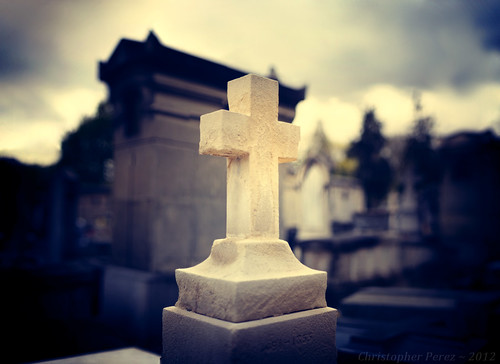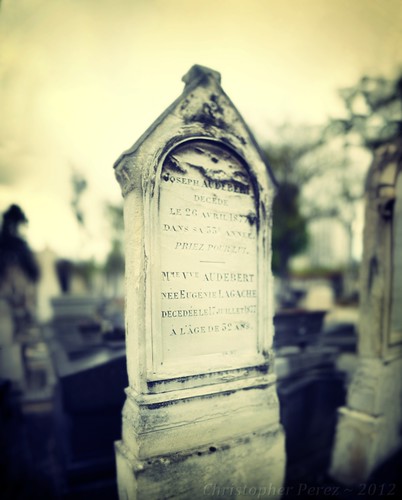Before we moved to Paris I nearly sold my Nikon manual focus fast apertured lenses. In fact, I did sell the incredible 180mm f/2.8 Ai I owned. Fortunately, I kept nearly everything else, including the 24mm and 35mm f/2 Ai lenses, a 50mm f/1.4 and the very sharp 85mm f/2 Ai.
While visiting the Montparnasse Cemetery to say thank you to Soeur Rosalie, I took just a few moments to try my hand at making three images. So far I have processed two of them and find that I'm very pleased with the results.

The technique is rather straight forward. Take one Sony APS-C sensored NEX5 and mount up that nice Nikon 50mm f/1.4 and shoot it wide open (you might need a ND or Polarizing filter to knock down the exposure in full sun). Put the camera into Manual exposure mode and meter the most important part of the scene. Use that exposure for all shots in the sequence that follows. Take a series of overlapped images somewhat near the primary subject, spilling the scene well beyond the subject so as to make sure you have covered the scene with enough room to work with. Stitch the images using Hugin's latest version of open source software or the University of British Columbia's "Autostitch" trial version. Save a sufficiently large result of the "Ransac'd" output (I like 6000x6000 pixels for the level of resolution I get in the final processed images). Process to taste.
Yes. I think the technique works.

It reminds me of shooting 4x5inch large format film using old fast optics shot wide open. I LOVED those old cameras and lenses and sometimes miss the technique. Alas, in the digital age my output has increased so dramatically that I can't go back. So I'm very happy to have found a hybrid approach that helps me achieve the kinds of things I used to dream of doing in 4x5.
All it takes is a little vision and away you go!
While visiting the Montparnasse Cemetery to say thank you to Soeur Rosalie, I took just a few moments to try my hand at making three images. So far I have processed two of them and find that I'm very pleased with the results.

The technique is rather straight forward. Take one Sony APS-C sensored NEX5 and mount up that nice Nikon 50mm f/1.4 and shoot it wide open (you might need a ND or Polarizing filter to knock down the exposure in full sun). Put the camera into Manual exposure mode and meter the most important part of the scene. Use that exposure for all shots in the sequence that follows. Take a series of overlapped images somewhat near the primary subject, spilling the scene well beyond the subject so as to make sure you have covered the scene with enough room to work with. Stitch the images using Hugin's latest version of open source software or the University of British Columbia's "Autostitch" trial version. Save a sufficiently large result of the "Ransac'd" output (I like 6000x6000 pixels for the level of resolution I get in the final processed images). Process to taste.
Yes. I think the technique works.

It reminds me of shooting 4x5inch large format film using old fast optics shot wide open. I LOVED those old cameras and lenses and sometimes miss the technique. Alas, in the digital age my output has increased so dramatically that I can't go back. So I'm very happy to have found a hybrid approach that helps me achieve the kinds of things I used to dream of doing in 4x5.
All it takes is a little vision and away you go!
10 comments:
Didn't quite understand how you are doing your latest, but that 2nd image is quite impressive. Would it work for portraits as well?
Erio, the technique would work for portraiture. It's how the process was first applied, for wedding portraits (bride and groom in a park setting), in fact. You'd need your subjects to be still while you accumulate the photos.
I didn't mean for you to give away your technique, but I do find it interesting. Like the shallow DOF of large format and my wet plates, it has the wonderful ethereal quality.
Erio, there's no issue "giving away" the technique. It's widely distributed and known as the Brenzier Method. Check it out - http://www.flickr.com/groups/brenizermethod/pool/
More importantly, have fun with it!!!
Interesting technique to create an out of focus background in a way that cannot be done with a single shot and a different lens. I never heard of it before.
But I do not like the results, at least not for the example given by Brenizer, the couple on the bridge. The annoying fuzzy background prevents my eyes from staying on the most important part of the picture, the couple.
However, it does work well for your picture of the cross here.
Could you do the same thing by using a wide angle lens and blurry the background in Photoshop?
Jacques, to the question of taking a wide angle lens and using PS to blur the backdrop, yes, there must be the "correct" math that will make the background do what you want. But... it's pretty complex software to synthesize and you might have to provide a little input on the various distances so the optical effects are properly rendered. I've tried a few plug-ins that claim to do what I want, but nothing has yet come close to the "real thing".
For me, it's easier to take an old "fast" manual focus optic and let the optics do what optics do and stitch these into a final result.
You're right about selecting the right subject matter. I got lucky in the cemetery and will head back to Montparnasse or go out to Pere Lachaisse to do more of this kind of work. I LOVE the effect, personally.
Do you have a special head on your tripod to properly position your camera when you take the pictures that you later stitch together? Or do you wing it, leaving a lot of overlap?
I made two devices which align images to the nodal point of just about any lens I own. I use them for architectural interiors where I want to make sure each section if perfectly aligned.
For out of focus background work, I don't need to be all that precise and just "splatter" as scene as best I can and let the software deal with the oddities.
Does your head allows you to taks a matrix of pictures, or only a row?
Show us a picture of it.
Post a Comment